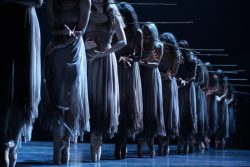 SEVEN years ago, when this production last visited Bristol, I went in the company of two traditional ballet lovers, who were genuinely shocked by what they saw on stage. Had they not been such polite guests I am sure, like quite a number of other members of the audience, they would have left at the interval. So unprepared was the audience for this radical re-imagining of the Giselle story, taking it from a beautiful Rhineland village in the Middle Ages to an arid condemned modern factory filled with vengeful ghosts, it was one of very few occasions when more than a handful of the audience actually left during the first act.
SEVEN years ago, when this production last visited Bristol, I went in the company of two traditional ballet lovers, who were genuinely shocked by what they saw on stage. Had they not been such polite guests I am sure, like quite a number of other members of the audience, they would have left at the interval. So unprepared was the audience for this radical re-imagining of the Giselle story, taking it from a beautiful Rhineland village in the Middle Ages to an arid condemned modern factory filled with vengeful ghosts, it was one of very few occasions when more than a handful of the audience actually left during the first act.
Fast forward seven years, during which, now quite aware that Akram’s raw powerful choreography and Vincenzo Lamagna’s matching score, using the Adam original as a basis, audiences now not only know what to expect, but would be upset if the production had been simplified or sanitised in any way.
Just as you can find traces of Adam’s music in Gavin Sutherland’s excellent orchestrations, played by the English Ballet Philharmonic, just as happy producing searing, dramatic sounds as they are making atmospheric screeches and squeaks not really of this world, so can you find the story of the tragic Giselle among this distinguished choreograohy. Wicked greedy landlords have replaced the landed gentry, but both have the all-enveloping power – and both abuse that power.
And in the middle of the turmoil is the innocent, dance-loving Giselle, driven to her death by betrayal and the vengeance of others. There is more a sense of power and strength, and the dangers that lurk beneath the abuse of either, than romance in Akram Khan’s vision of the story.
One thing that is never lost is the grace of movement that goes with strength and power. Exuding the graceful danger of a trapped panther, leopard, or cheetah, the company is as significant in the telling of this story as the four principals, Giselle, Albrecht, Hilarion and the wonderfully vengeful Myrtha. They are the link to the attitude of present-day society. It would be nice to name and give credit to those who played those roles so beautifully, but, like the producers in the film industry, who refuse to give actors a name credit in case they become too well known and ask for more money, ENB, in an otherwise splendid and informative programme, appear to be reluctant to make it easy to discover who danced what on which evening.
What it does tell you is that the magnificent moving sets, made to look even more imposing by a wonderfully atmospheric lighting plot, were created by Tim Yip and Mark Henderson. It is the marriage of those elements with the barbed-wire sounds of the music and Akram Khan’s choreographic imagination, that provide this vibrant young company with the ammunition to create a very different and always compelling version of a well-loved, (and still completely viable in its own right), ballet classic.
GRP